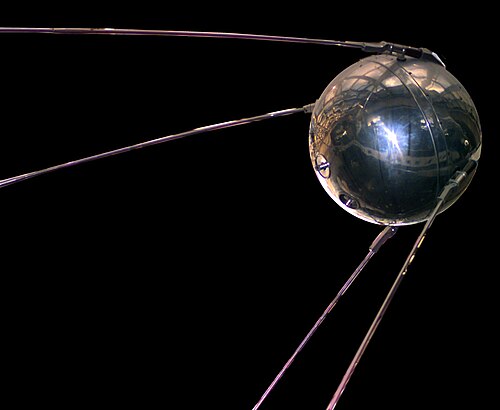Facts for Kids
The Space Race was a competition during the Cold War between the United States and the Soviet Union to achieve significant milestones in space exploration, characterized by technological advancements and iconic missions.
Overview
Key Events
Major Players
Cultural Impact
Political Implications
Legacy Of The Space Race
Technological Innovations
Future Of Space Exploration
Space Exploration Milestones

Inside this Article
Space Exploration
John F. Kennedy
Neil Armstrong
United States
Alan Shepard
Technology
Spacecraft
Communism
Universe
Did you know?
🚀 The Space Race was a 20th-century competition between the Soviet Union and the United States for supremacy in space exploration.
🌌 The launch of Sputnik 1 in 1957 marked the beginning of the Space Race.
🛰️ The first human, Yuri Gagarin, orbited the Earth on April 12, 1961, as part of the Soviet space program.
🌕 The United States achieved its goal of landing humans on the Moon on July 20, 1969, with Apollo 11.
📡 The Soviet Union launched the first space station, Salyut 1, in 1971.
🧑🚀 The Apollo program consisted of 17 missions, culminating in six successful Moon landings.
🌍 The Space Race significantly advanced technology in telecommunications and satellite systems.
👩🚀 Valentina Tereshkova became the first woman to fly in space in 1963.
📅 The race officially ended with the signing of the Apollo-Soyuz Test Project agreement in 1972.
🔭 The Space Race spurred international cooperation in space exploration in subsequent decades.
Introduction
The main goal was to see who could explore space first and accomplish incredible things like sending satellites and humans to the Moon. The Space Race inspired many people and led to remarkable advancements in science and technology. 🚀
Would you believe that the first object humans ever sent to space was a satellite called Sputnik 1 launched by the Soviet Union in 1957? 🌌
Key Events
This was the very first satellite to orbit Earth. A year later, in 1958, the United States launched its own satellite, Explorer 1. 🚀
Then came Vostok 1, on April 12, 1961, when tall cosmonaut Yuri Gagarin became the first human to travel into space. 🌟
The United States answered by launching John Glenn into orbit in 1962. Finally, on July 20, 1969, Neil Armstrong and Buzz Aldrin from the USA became the first humans to walk on the Moon during Apollo 11! 🌕
Major Players
Korolev was the leading rocket designer, while Gagarin became the first human in space! 🌌
In the United States, President John F. Kennedy was a strong supporter of space travel. He famously declared in 1961 that America would land on the Moon before the decade's end. 🌠
Additionally, astronauts like Neil Armstrong, Buzz Aldrin, and Michael Collins helped make this dream a reality! 🧑
🚀
Cultural Impact
Movies, cartoons, and books about astronauts and aliens became popular. Kids loved telling stories about living on the Moon or meeting Martians! 🌌
Songs, like "Rocket Man," became hits too! The race made everyone excited to learn about science! Schools created science and math programs to inspire new generations of scientists and engineers. 📚
The Space Race also encouraged many dreams and imaginations about what might be out there in the universe! 🌠
Political Implications
️ The competition represented the battle between democracy (USA) and communism (Soviet Union). Each side wanted to show its power and technological advantages. Winning the Space Race was like winning a trophy for political pride! 🏆
The Soviet Union's early victories caused worry in the United States, leading to more investments in education and science programs. By landing on the Moon, the USA showcased their technological superiority, which had deep effects on their role in global politics! 🌏
Legacy Of The Space Race
It showed the world how important space exploration is and inspired many generations to dream big. 🚀
Today, we continue to explore space, send rovers to Mars, and even think about sending humans to other planets like Mars! 🪐
Space programs worldwide work together, sharing knowledge and technology. The Space Race also sparked schools to teach kids about science, helping to create countless inventors, engineers, and astronauts. 🌠
The story of space exploration continues to inspire people to reach for the stars! 🌟
Technological Innovations
One of the first technologies was the rocket, which uses powerful engines to break free from Earth's gravity. Early rockets included the Vostok and Saturn V rockets. 🌠
Satellites, like the very first one, Sputnik 1, helped scientists learn about Earth and space. Another innovation was the development of computers, which helped control spacecraft. They were big back then, but now we have tiny computers in our phones! 📱
Even Tang, the orange drink, became popular because astronauts mixed it with water in space. 🍊😄
Future Of Space Exploration
NASA, SpaceX, and other organizations are working on many amazing projects. For example, NASA's Artemis mission will send astronauts back to the Moon by 2025! 🌕
Scientists are also planning to send humans to Mars in the 2030s! 🪐
Additionally, new companies are developing rockets that can take satellites and tourists to space. One day, you might even visit a space hotel! 🏨✨ With new technology and cooperation between countries, who knows what incredible discoveries await us in the universe! 🌌
Space Exploration Milestones
In 1957, the Soviet Union launched Sputnik 1, the first artificial satellite. 🌍
A few months later, they sent Laika, a dog, into space on Sputnik 2! The USA's first human in space was Alan Shepard, flying in Freedom 7 in 1961! ✈
️ Then came the famous Apollo 11 mission, where Neil Armstrong took "one small step for man, one giant leap for mankind" on the Moon! 🌕
The Soviet Union's final step was the Luna 16 mission, which returned Moon soil in 1970! 🌌

